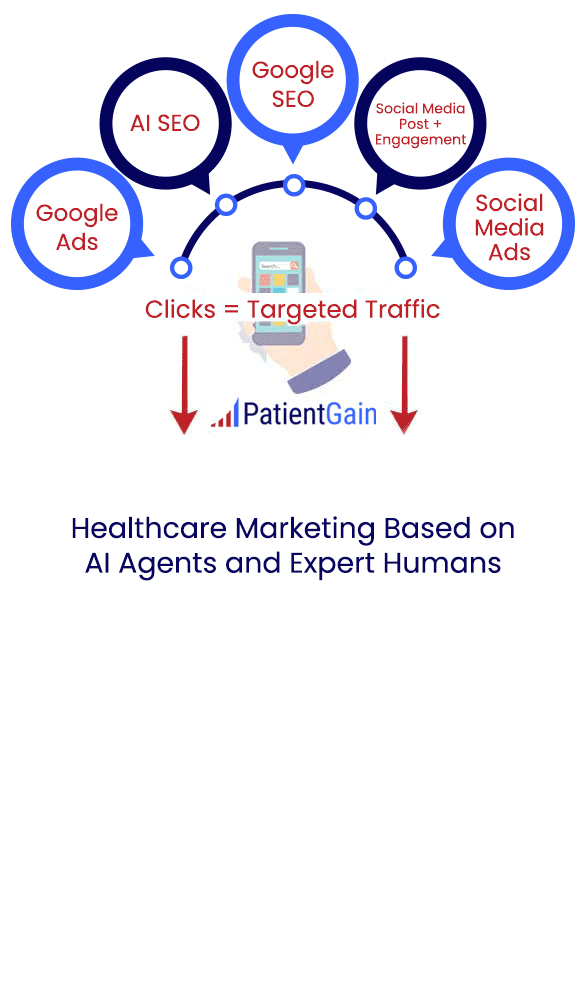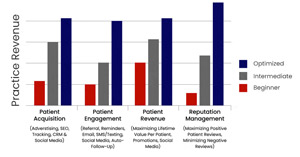What is a Medical Marketing CRM ? Is it HIPAA Compliant?
Patient marketing database VS EMR, What is a patient marketing database, and what kind of data does it store? Best medical practices are now using Medical Marketing CRMs to gain competitive advantage. These marketing databases are connected and integrated with medical websites and intelligent patient engagement ChatBots. This database must also be HIPAA compliant. PatientGain offers this CRM database with its services.

As patients interact with your website, your email marketing, Texting/SMS, Facebook business page, you would want to store the information about each interaction in a database. This database is called a medical marketing CRM. It is an intelligent software that can also integrate with your EMR or EHR system securely, and leverage the hidden useful information in your EMR. So medical marketing CRM software is used to store prospect patient information and any interactions, before a patient becomes a patient. Many times, after a prospect patient has been converted to a patient, you would still want to keep the patient information, in addition to your EMR. EMR and Practice Management or Patient Billing/Revenue systems are not designed to market to patients. Lead capture and follow up is becoming important as patients require multiple touch points.

When running a medical practice, doctors and owners will rely on databases to keep information on their patients organized. They should maintain two critical databases: their patient marketing database and EMR (electronic medical record.) Some medical practices mistakenly consider these the same thing; however, they are not and should ultimately be kept separate. An EMR holds the records of current patients, while a patient marketing database, sometimes called a CRM, contains records of current and prospective patients. Every current patient of medical practice was once a “prospect patient.” The patient marketing database is immensely beneficial because various apps and services can be plugged into it, allowing a medical practice to market to them efficiently.
What is a patient marketing database, and what kind of data does it store?
A patient marketing database can also be known as a CRM or a customer relationship management system. A CRM in a healthcare setting will collect various information from multiple sources. Depending on the needs of a medical practice, a mountain of data can be collected by a patient marketing database. The more data it has, the more finely tuned a marketing message can be for a campaign. Some of the things this database will collect include:
- Patient name (Lead name)
- Phone
- Cell phone (for texting)
- Source of lead – Like Facebook, Google Ads, Texting app, Newsletter
- Date of lead added
- Date of last contact
- Type of patient – Inquiry related to : 1. Promotion 2. Botox service, Hip surgery etc
- Status of life-cycle – like Prospect, Seen at Clinic, Interested but not seen, unhappy patient, happy with service ( will provide a review or a referral), Insurance or self pay
- Responsible person for follow up. Name, email of the person in your office, who is responsible for following up.
- Next steps for follow up with the patient
- Referral sources of the prospect patient
- Send thank you to”referral source” ?
- Store demographic data ? (for marketing purposes – Non medical data)
- Social Media Channels
- The last time they visited
All in all, a patient marketing database aims to provide a complete picture of a patient’s activities and overall habits. Medical practices can use this database to engage with current and potential patients. The idea is to acquire new patients by converting prospective patients into actual patients and then retaining all current patients continuing to seek care at a medical practice.
There are many benefits to having a healthcare patient marketing database and using it as the principal data repository from current and potential patients. These databases are generally platform agnostic, meaning they can integrate with various healthcare and marketing technologies. A database can help a medical practice find growth opportunities and focus marketing campaigns on specific demographics of their current and prospective patients. A variety of other metrics can be pulled from other sources, like an integrated EMR to develop customized marketing campaigns that will result in high engagement and conversions.
Patient marketing databases can also help a medical practice evaluate which marketing methods work best overall. They can see if patients respond more to social media campaigns, email marketing, text message marketing, or even direct mail campaigns. Over time, this cornucopia of data will only help a medical marketing plan refine campaigns to be more effective. Patient marketing databases are more effective if everyone at a medical practice can contribute data to them, from doctors to the medical receptionists. With that in mind, any patient marketing database still needs to be HIPAA compliant to ensure all data is protected.
What is an EMR, and what kind of data does it store?
Just about every medical practice today uses an EMR or electronic medical records. They are the digital version of paper charts one has in a clinician’s office. While some doctors do not use an EMR, it is infrequent. Without an EMR, it is challenging to send medical data to other doctors or specialists without it being a very time-consuming process. Another way to look at an EMR is to think of old movies where scenes would take place in hospitals. A doctor would come in, pick up a chart hanging at the edge of a bed, and review the notes on it about a patient. Today, all of that data can be sent and stored on a tablet and walked around with a doctor to patient to patient. With a secure EMR, the doctor can pull up data and look at other notes another provider may have added almost in real time.
EMRs also allow doctors to easily track data over time, such as changes someone’s blood pressure or glucose levels. The database is organized and can be sorted to identify which patients are due for checkups or other preventive screenings. EMRs also allow doctors to monitor patients remotely so if another provider sees them, they can quickly review the results of that appointment. Finally, a medical practice can review the overall data collected by an EMR to determine the quality of care at a practice and what areas need improvement.
EMRs previously did not have an easy time sending data from practice to practice. However, various laws and regulations have come into place to make it easier for patients to take their medical data with them. It is less common for patients to print out their entire medical record and take it to a new doctor or hospital system. Generally, most medical records can be transferred digitally or stored on an electronic device to be taken to another location. It may take some time to transmit that data into a new medical record, but it is much easier today than it was even 5 or 10 years ago.
Why is a patient marketing database valuable to a medical practice?
A patient marketing database is valuable because there are a variety of apps that can be built on top of it and interact with it for marketing. PatientGain.com has a variety of apps that can be integrated with a CRM to increase the power of a digital medical marketing plan. Below are just a few examples; view the rest here.
Digital Intake Forms
One of the most significant complaints patients have, and many medical receptionists’ bane, is intake forms. Previously, these forms would be given to a patient when they arrive on a clipboard, and they would then have to fill them out in a waiting room. Many patients would have to arrive 30 minutes early before their first appointment to get through the multitude of different forms and paperwork to complete. Medical receptionists would then have to take those forms and enter the information into the EMR database. That could be a challenge depending on how sloppy a patient’s handwriting was.
Digital intake forms save patients and staff time and reduce possible errors in an EMR. These secure, HIPAA-compliant forms allow a patient to fill them out at home if they have time or from their phone. Once submitted, they will then be transmitted to the EMR and uploaded where staff can check to make sure fields have been filled in correctly. Digital intake forms also collect demographic information, like age, address, email address, and cell phone numbers. This information can be uploaded to a patient marketing database and organized for future marketing campaigns. Medical practices can refine campaigns to target neighborhoods or patients by their age.
Reputation Management
The online reputation of a medical practice is critical to its success. They will have difficulty attracting new patients if they have a negative reputation online. The online reviews are among the first things a prospective patient will check before making a healthcare decision. These reviews and the reputation of medical practice need to be managed. Even if a medical practice had good reviews, they need to obtain as many as possible. A medical practice with a 4.7 rating with 300+ reviews will look more reliable and authoritative than a medical practice with a 5.0 rating and eight reviews. To get positive reviews for a medical practice, all a practice needs is to ask a patient.
This is where a patient marketing database comes in. A reputation management app will take the data from this database and send out review requests. It will know when the patient visited and send out a review request. Some medical practices like to send out requests the day after a visit and follow up days later if it appears there was no engagement with the message. It should be as easy as possible with as few clicks as possible to leave feedback to get the most reviews. With every additional click it takes to leave a positive review, more and more patients will abandon that process. A patient marketing database can provide the emails or cell phone numbers for email review requests or text message review requests.
Email Marketing
Although not as potent as it once was, email marketing remains a popular marketing method in the quiver of many medical practices. Doctors and owners use email marketing to engage with their current patients and keep them up to date with what is going on at the medical practice. Emails in email marketing campaigns need to be engaging, useful, and informative. Simply sending an email out every week reminding patients of the hours of operation will lead to low open rates and higher unsubscribe rates. Instead, the message in an email marketing message should include:
- Some information about a health concern.
- A link to a current blog post.
- A profile of a new provider or staff member.
- A promotion of a service.
These are the things a patient might need or be interested in. For medical practices, an email marketing message every 2 to 4 weeks is generally a reasonable rate to aim for in most circumstances.
An email marking app will work directly with a patient marketing database. Email messages can be customized to address the person it is being sent to. So instead of it saying, “Dear Patient,” it will address the person by their first name and last name. It is crucial to ensure the data in that database is correct. John Smith is likely to ignore a message addressed to “sMith Jon.” The database will also keep track of the last time the person was messaged, if they clicked on any links, and remove them from an email list if they ever decide to unsubscribe. This will keep the medical practice safe from violating federal email and spam laws.
2 -Way Text Message App
Text message marketing is becoming very popular with medical practices. Although they are a little more expensive than email marketing and messages must be shorter, they have much higher open rates. Just about everyone has a cellphone today and can accept texts. Most people prefer to get text messages from friends, family, and even businesses rather than take a phone call. Text message marketing lets medical practices send out important messages to their patients promoting a service or informing them of a schedule change. Text message marketing messages are usually limited to 240 characters. With that in mind, these messages need to identify themselves, give a call to action, and then provide a link for further information.
A patient marketing database functions much as it does with email marketing. They will be able to import cell phone numbers into a text message marketing app. A database plays an essential role by differentiating between home phone numbers (that can not get texts) and cell phone numbers. Again, a patient marketing database will track when messages are sent and the engagement. Text message marketing campaigns should be less frequent than email marketing campaigns. More than one a month risk high unsubscribe rates and phone call complaints to the front desk.
Online Appointments
More and more medical practices are offering the ability for patients to manage their visits to their doctors by giving them access to online appointments. Patients today want more control of their healthcare decisions, and online appointments provide them with part of that control. One of the best benefits of online appointments is that it does not rely on staff availability to schedule them. A patient can schedule or manage their appointments after business hours, over holidays, or even when no one is available to take a phone call. Online appointment systems also have email and text reminders to ensure patients do not miss their doctor’s appointments.
This system, often combined with online intake forms, feeds information into a patient marketing database. It will tell a database the date and type of a patient’s appointment. This information, in turn, can be used to send out review reminders or send an email marketing message based on the amount of time that has passed since their last visit. For example, a patient marketing database could produce a list of patients who’s last visit was more than six months ago, and then a campaign can be created to encourage them to come back for a checkup.
Overall, a patient marketing database is crucial for a medical practice’s medical marketing plan. While similar in some respects, it is not the EMR that practices will use to manage the health of their patients. Patient marketing databases should have more records than an EMR since they include current patients and prospective patients. PatientGAin.com has a variety of apps that work with these databases to make your marketing plans even more effective. The experts at PatientGain.com are available to help you create a high-performance healthcare website. Contact us today and let us show you what we have done for other practices across the country!


